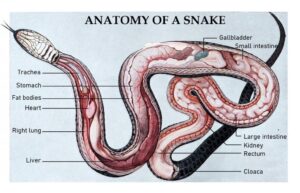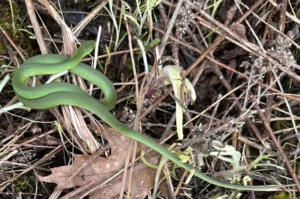You’ve probably heard someone say they saw a snake chopped in half, and both sides started wriggling around like they were alive. But is any of that actually real?
No, a snake can not survive being cut in half. It may move for a little while after being cut, but this movement is not a sign of life. It is just the nerves reacting. Once the body is split, the organs stop working, and the snake cannot breathe, eat, or live.
This myth that snakes can survive being cut in two often causes people to treat snakes very badly.
Some people might hurt snakes, thinking they won’t really die. But that’s none of this is true.
Also, TV shows and movies sometimes show snakes staying alive after being cut, which further spreads the myth.
What’s Inside a Snake’s Body?
Snakes look nothing like us (unless you’re really bendy), but their insides are not that different.
They’ve got hearts, lungs, brains, and many of the same parts we do, just stretched out, like someone ran them through a pasta maker.

Their backbone is made of a ton of little bones, which is how they do all that slithering and twisting. No arms, no legs, just one long noodle full of organs.
The heart is not up near the head like ours, it’s a little further back. The lungs are super long and skinny, like a balloon (most snakes only have one functional lung).
Here’s something interesting about snakes. Their brain controls some things, but not everything.
Things like breathing and keeping their heart beating happen without the brain telling them to. This is important to remember.
What Happens If a Snake Is Cut in Half?
When a snake gets cut in half, it dies right away. Here’s why this happens.
- Blood loss – Like people, snakes need blood to stay alive. If they lose too much blood, they die.
- Breathing – Snakes need muscles to help them breathe. When they get cut in half, these muscles can’t work right. When cut in half the snake can’t breathe anymore.
- Shock – A big injury like this also puts the snake’s body into shock. That means the body can’t work right anymore. This shock can also kill the snake very quickly.
Also, a snake’s body has many parts that help it live; like the heart, lungs, liver, and more. These parts are spread out in the body.
If you cut a snake in half, some of these important parts are destroyed or separated. The snake cannot live without them all working together.
Why Do Dead Snakes Still Wiggle?
If a snake is dead, it will not stop moving right away. The body will continue to move for some minutes or even an hour. This is the reason why people believe that the snake is alive.
This happens because of nerves. Imagine that nerves are wires in your body. Even if the snake were dead, these “wires” can still send signals to the muscles. This makes the muscles move even though the snake is dead.
The moving can look pretty real. The snake will twist around, open its jaws wide, or even attempt to bite. But it is all the last spasm of the body. The snake is not actually alive.
It is similar to when you turn a TV off and the screen just stays lit for a moment before it turns dark. The TV is no longer on, but there is still power flowing through it.
Can Snakes Grow Back Lost Parts?
You might be wondering if snakes can grow back the missing half of their body.
Some animals can grow back lost body parts. Lizards can regrow their tails. Starfish can regrow their arms. Some worms can even regrow their whole body from a small piece.
But snakes can’t do that. They never developed his ability.
Why can’t snakes regrow body parts like other animals? Because they’re too complicated. It’s easy for simple animals like worms to do because they don’t have many different pieces.
But snakes have complex hearts, brains, and other organs.
Can a Snake Bite After Being Cut in half?
Surprisingly, dead snakes can still bite you. If the head is still fresh, the nerves might still fire off, and bam, you get bitten.
In some cases, a dead venomous snake head can still deliver venom.
This is because the venom glands are located in the head. If the fangs can still move, they can deliver venom.
So even if a snake seems dead, don’t go near it. Especially not its head.
What to Do if You Find an Injured Snake
If you find a snake that appears injured, it’s a good idea to leave it alone.
Do not try to touch or interact with the snake in any way.
Handling a distressed snake with bare hands is risky. If you’re unsure about the species (venomous or non-venomous), do not try to touch or move it.

If you are sure the snake is non-venomous, you can gently guide it into a container for temporary holding.
Use a plastic storage bin, box, or bucket with a tight lid and ventilation holes.
Place a clean towel or soft cloth at the bottom to cushion and calm the snake.
Keep the container in a quiet, shaded, and temperature-stable location.
Once the snake is safely contained, call a local wildlife rehabilitation center, or a veterinarian.
As you wait for help, avoid giving the snake any ‘first aid’. It’s natural to want to help, but treating an injured snake without proper knowledge can cause more harm than good.
Conclusion
The old rumor about snakes living after you cut them in half is just a myth. Snakes are fascinating creatures, but they’re not superheroes.
Cut one in half and, well, neither piece is making a comeback.
If we want to keep seeing snakes slither around, we need to take care of their habitats and stop spreading harmful myths about them.
Keep learning and the next time someone brings up that zombie snake story, you’ll be ready to clear things up.
Sources:
Willhite, L. A., Willenbring, B. A., Orozco, B. S., & Cole, J. B. (2018). Death after bite from severed snake head. Clinical Toxicology, 56(9), 864–865. https://doi.org/10.1080/15563650.2018.1439951
Moradi AM, Aj O, Paydar S, Ketabchi F, Sheid Moosavi SM, Bolandparvaz S, Abassi HR, Tamadon AD, Mehrabani D. The Effect of Blood Loss in the Presence and Absence of Severe Soft Tissue Injury on Hemodynamic and Metabolic Parameters; an Experimental study.
Stinner JN. Functional anatomy of the lung of the snake Pituophis melanoleucus. Am J Physiol. 1982 Sep;243(3):R251-7. doi: 10.1152/ajpregu.1982.243.3.R251. PMID: 7114286.
Hi, my name is Ezra Mushala, i have been interested animals all my life. I am the main author and editor here at snakeinformer.com.

